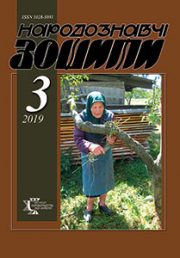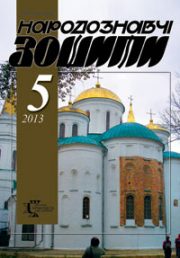The Ethnology Notebooks. 2019, № 6 (150), 1420—1431
UDK7.011:7.033.21(4)
DOI https://doi.org/10.15407/nz2019.06.1420
HERII Oksana
ORCID ID: https://orcid.org/0000-0002-8383-227X
Ph.D in Art Studies,
Senior Researcher at the Art Studies Department,
The Institute of Ethnology of the National Academy of Sciences of Ukraine.
15 Svobody Avenue, 79000, Lviv, Ukraine.
Contacts: e-mail: oheriy@ukr.net
Abstract. Introduction. Since the construction of the Hagia Sophia in Constantinople the dome became the central compositional and semantic element of the Byzantine church architecture. The dome in most churches is carried on four spherical triangular pendentives. The pendentives are the corners of the square base of the dome, which curve upwards into the dome to support it. Theirs function and theirs location between the tier of the earth and the upper tier of the vaults (between the earth and the sky) gave them the symbolic meaning.
Problem statement. Since the formation of the Byzantine temple painting system in the post-iconoclastic period the images of four Evangelists were depicted on four pendentives. Many researchers have mentioned the Evangelists representation on the pendentives, but they did not pay attention to the sequence of the placement of these portraits. Almost all decorators of the domed churches in Ukraine at the end of 19th — beginning of 20th century followed the rule for placing the portraits of Evangelists on the pendentives, but they did not use one sequence. Our research and systematization the wall painting examples in the domed churches in Ukraine revealed at least three basic orders of the Evangelists depiction under the dome. So the purpose of this article is to answer the question: why were there the three basic orders and how did differ their meaning?
Methods. The answer is sought through a comparison of the symbolic meaning of architectural elements, their function and their location with the semantics of Evangelists images.
Results. Associated with the Evangelists images of living creatures from Revelation (the lion, the calf, the man and the eagle) added important additional information to the understanding of the arrangement of the paintings in the temple interior. The research begins with the first survived Christian buildings — the Catacombs of Rome, where two lines of symbolization of the angles of the vault are noted: «astronomical» and «blessed». When the focus was on images of the living creatures (mosaics of the Ravenna churches), astronomical symbolism prevailed and embodied in a specific circular sequence. When the authority of the authors of the New Testament grew, the order of the Evangelists images was equal to the order of four books in the Gospel.
Conclusions. The historically formed symbolic meaning of the Evangelists images location order allowed artists to choose the desired semantic shade to more accurately express the main idea of temple decoration.
Keywords: four symbols of the Evangelists, living creatures from Revelation, Ezekiel’s vision, circle of the zodiac, Ravenna mosaics, temple painting system.
Received 19.11.2019
REFERENCES
Millet, G. (1932). L’Art byzantin chez les Slaves. Paris: Librairie orientaliste Paul Geuthner [in French].
Grabar, A. (1957). L’iconoclasme byzantin. Dossier archйologique. Paris: Collиge de France [in French].
Demus, O. (1964). Byzantine Mosaic Decoration: Aspects of Monumental Art in Byzantium. Boston.
Lazarev, V.N. (1986). The History of Byzantine painting (Vol. 1). Moscow: Iskusstvo [in Russian].
Lohvyn, H.N. (1968). Across Ukraine: Ancient Art Monuments. Kyiv: Mystetstvo [in Ukrainian].
Mathews, T. (1994). The transforming symbolism of Byzantine architecture and the image of the Pantocrator in the dome. East Christian Temple: Liturgy and Art. St. Petersburg: Centr vostochnohristianskoj kul’tury (Pp. 7—14) [in Russian].
Mamolat, E.S., & Aseiev, J. (Ed.). (1966). The Monumental painting. In J. Aseiev. The History of Ukrainian Art (Vol. 1, pp. 246—321). Kiev: Academy of Sciences of the Ukrainian SSR [in Ukrainian].
Nelson, R.S. (1980). The Iconography of Preface and Miniature in the Byzantine Gospel Book. New York: University Press.
Hellemo, G. (1989). Adventus Domini: Eschatological thought in 4th-century apses and catecheses. Leiden; New York; Kobenhavn; Kцln: E.J. Brill.
Podosinov, A.V. (2000). Symbols of the Four Evangelists: Their Origin and Significance. Moscow: Jazyki russkoj kultury[in Russian].
Schaff, F. (2010). The History of the Christian Church: in 8 vols. (Vol. 1). St. Petersburg: Biblija dlja vseh [in Russian].
Gukova, S. (2005). Virgin with the symbols of the evangelists. Вyzantina Xponika, 64, 256—270 [in Russian].
Irenaeus of Lyon. (2010). Against Heresies: The Proof of the Apostolic Sermon. Moscow: Oleg Abyshko Publishing House [in Russian].
Nilgen, U. (1973). Evangelisten symbole. Reallexikon zur deutschen Kunstgeschichte (Vol. 6, pp. 517—572). Mьnchen [in German].
Werner, M. (1989/1990). On the Origin of Zoanthropomorphic Evangelist Symbols: The Early Medieval and Later Coptic, Nubian, Ethiopian and Latin Evidence. Studies in Iconography, 13, 1—47.
Saint Gregory the Great. (1863). Conversations on the prophet Isaac: in 2 books (B. 1). Kazan: M. Shogin and K. Printing house [in Russian].
Grooth, М. de & Moorsel, P. van. (1977/1978). The lion, the calf, the man and the eagle in early Christian and Coptic art. BABesch (Bulletin Antieke Beschaving), 52/53, 233—245.
Pokrovskij, N. (1900). Essays about the Monuments of Christian Iconography and Art. St. Petersburg: A. Lopuhin Printing house [in Russian].
Peers, G. (2001). Subtle Bodies: Representing Angels in Byzantium. Los Angeles: University of California Press.
Kinney, D., Emmerson, R., & McGinn, B. (Eds.). (1992). The Apocalypse in Early Christian Monumental Decoration. In R.K. Emmerson & B. McGinn. The Apocalypse in the Middle Ages (Pp. 200—216). Ithaca & London: Cornell University Press.
Henning, R. (1973). Les grandes йnigmes de l’univers. Paris: R. Laffont [in French].
Borges J.L. (2000). Bestiary: A book of fictional creatures. Moscow: EKSMO-Press [in Russian].
Klymyshyna, I.A., & Korsun’, A.O. (2003). Astronomical Encyclopedic Dictionary. Lviv [in Ukrainian].
Rцck, F. (1930). Die kulturhistorische Bedeutung von Ortungsreihen und Ortungsbildern: Ein Beitrag zur vergleichenden Chronologie. Anthropos: Internationale Zeitschrift fьr Vцlker- und Sprachenkunde, 25, 255—302 [in German].
Sydor, O. (2014). The World of Astronomy in the Images of Ukrainian Art. In O. Petruk (Ed.). The Ukrainian Sky: Studies on the History of Astronomy in Ukraine (Pp. 226—317). Lviv [in Ukrainian].







